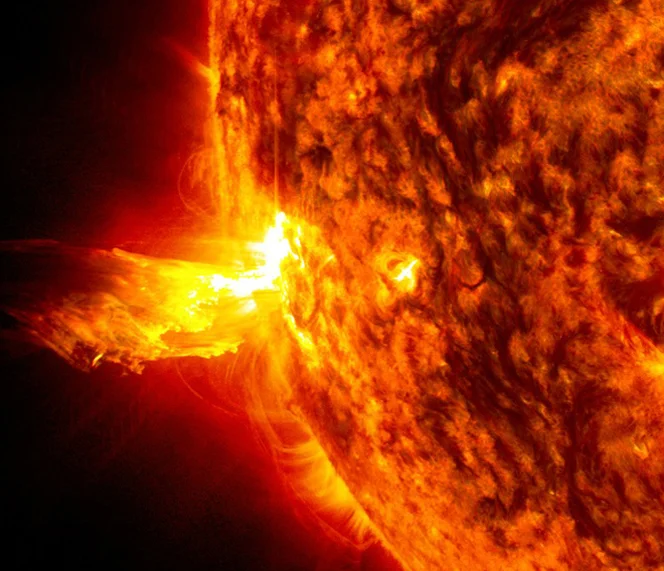Article Outline:
Article Outline:
- Introduction
- Understanding Solar Flares
- Definition of Solar Flares
- Causes of Solar Flares
- Impact of Solar Flares on Earth
- The Sun and Solar Power
- Introduction to the Sun
- Harnessing Solar Power
- Advantages of Solar Power
- The Role of ISRO in Solar Flare Research
- Introduction to ISRO
- ISRO's Contributions to Solar Flare Research
- Collaborations and Partnerships
- Utilizing Solar Power for a Sustainable Future
- Importance of Clean Energy
- Applications of Solar Power
- Advancements in Solar Power Technology
- Challenges and Future Perspectives
- Challenges in Solar Power Implementation
- Innovations and Solutions
- The Future of Solar Power
- Conclusion
-
FAQs
Article:
Introduction
The Sun, our mighty celestial neighbor, holds unfathomable power within
its core. One such manifestation of this extraordinary power is a
phenomenon called solar flares. Solar flares have captivated scientists
and researchers for their intriguing nature and potential impacts on
Earth. In this article, we delve deeper into the world of solar flares,
explore the role of ISRO (Indian Space Research Organization), and
discover the vast potential of solar power in creating a sustainable
future.
Understanding Solar Flares
Solar flares can be described as powerful eruptions of energy and
radiation from the Sun's surface. These eruptions release an enormous
amount of energy, surging particles and electromagnetic radiation into
space. The impacts of solar flares can range from stunning displays of
auroras to disruptions in communication systems and power grids on
Earth.
Solar flares are caused by complex interactions within the Sun's
magnetic field. The sudden reconfiguration of magnetic fields releases
tremendous amounts of energy, resulting in the eruption of plasma and
charged particles. Understanding these mechanisms is vital in preparing
for the potential consequences of solar flares.
The Sun and Solar Power
The Sun, our very own star, provides an abundant source of energy that
can be harnessed using solar power technologies. Solar power is the
conversion of sunlight into usable energy, predominantly through the use
of photovoltaic cells or concentrated solar power systems. By capturing
the Sun's energy, we can generate electricity, heat water, and power
various devices.
Harnessing solar power has numerous advantages. Firstly, it is a
renewable source of energy, meaning it will not deplete like fossil
fuels. Additionally, solar power systems produce zero greenhouse gas
emissions, making it an environmentally friendly alternative. Moreover,
solar power can be decentralized, empowering individuals and communities
to generate their own electricity and reduce reliance on traditional
energy sources.
The Role of ISRO in Solar Flare Research
The Indian Space Research Organization (ISRO) has been at the forefront
of space exploration and research for several decades. ISRO recognizes
the significance of solar flares and their potential impacts on Earth's
technological infrastructure. Hence, they have made substantial
contributions to the study and understanding of solar flares.
ISRO actively collaborates with global space agencies, universities,
and research institutions to exchange knowledge and expertise in solar
flare research. These partnerships foster advancements in solar flare
prediction models, allowing for better preparedness and mitigation
strategies in the face of potential solar flare events.
Utilizing Solar Power for a Sustainable Future
As the world recognizes the urgency to transition to clean and
sustainable forms of energy, solar power emerges as a frontrunner in the
race towards a greener future. The importance of clean energy cannot be
stressed enough, as it plays a crucial role in mitigating climate change
and reducing our dependence on fossil fuels.
The applications of solar power are vast and diverse. From residential
solar panels and solar-powered streetlights to large-scale solar farms
and solar-powered vehicles, the potential is endless. Technological
advancements in solar power systems, such as efficient storage solutions
and flexible solar panels, are propelling this renewable energy source
towards widespread adoption.
Challenges and Future Perspectives
While solar power holds immense promise, there are challenges that need
to be addressed for its widespread implementation. One significant
challenge is the intermittency of solar power generation, as it is
dependent on sunlight availability. However, innovations like energy
storage systems and grid integration solutions are mitigating this
challenge.
The future of solar power looks promising as research and development
in this field continue to soar. Innovations such as solar cell
efficiency enhancements, cost reduction, and integration with other
renewable energy sources are paving the way for a sustainable and
reliable energy future. Governments and organizations worldwide are
investing in solar power research and infrastructure to accelerate the
adoption of clean energy.
Conclusion
Solar flares and solar power exemplify the sheer power and potential of
our nearest star, the Sun. They offer both challenges and opportunities
for our planet and its inhabitants. While solar flares pose potential
risks to our technological systems, understanding this phenomenon helps
us prepare and protect ourselves. Simultaneously, solar power presents a
clean and renewable energy solution that can drive us towards a greener
and sustainable future. With continued research and innovation, we can
harness the Sun's energy to meet our growing energy demands while
preserving our planet.
FAQs
- Q: Are solar flares dangerous to humans?
- A: Solar flares, at their current observed intensity, do not pose a direct threat to human health.
- Q: Can solar flares cause power outages?
- A: Yes, powerful solar flares can disrupt power grids and communication systems on Earth.
- Q: Is solar power expensive?
- A: The cost of solar power systems has significantly decreased over the years, making it more affordable and accessible.
- Q: How can solar power benefit developing countries?
- A: Solar power provides a sustainable energy solution for regions without reliable access to conventional electricity grids.
- Q: What is the biggest advantage of solar power?
- A: Solar power is a renewable and clean energy source, reducing reliance on fossil fuels and mitigating environmental impacts.



0 Comments